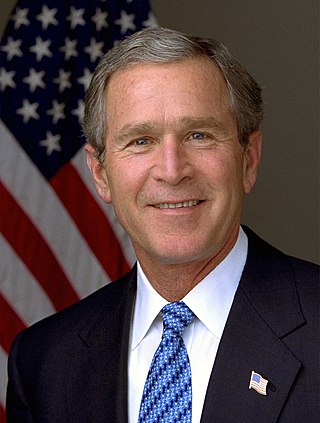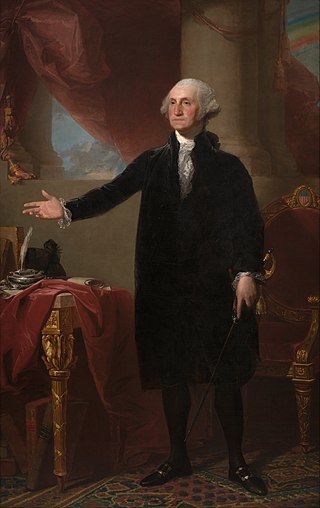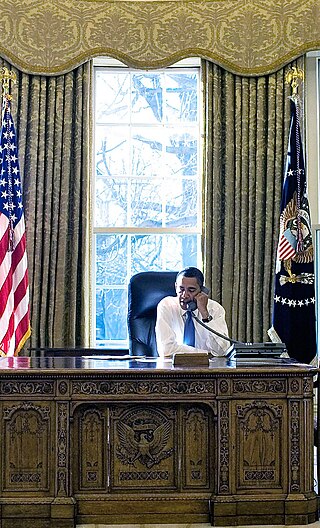
George W. Bush's tenure as the 43rd president of the United States began with his first inauguration on January 20, 2001, and ended on January 20, 2009. Bush, a Republican from Texas, took office following his narrow Electoral College victory over Democratic incumbent vice president Al Gore in the 2000 presidential election, in which he lost the popular vote to Gore by 543,895 votes. Four years later, in the 2004 presidential election, he narrowly defeated Democrat nominee John Kerry, to win re-election. Bush served two terms and was succeeded by Democrat Barack Obama, who won the 2008 presidential election. Bush is the eldest son of the 41st president, George H. W. Bush.

The oath of office of the president of the United States is the oath or affirmation that the president of the United States takes upon assuming office. The wording of the oath is specified in Article II, Section One, Clause 8, of the United States Constitution, and a new president must take it before exercising or carrying out any official powers or duties.

In political studies, surveys have been conducted in order to construct historical rankings of the success of the presidents of the United States. Ranking systems are usually based on surveys of academic historians and political scientists or popular opinion. The scholarly rankings focus on presidential achievements, leadership qualities, failures, and faults. Popular-opinion polls typically focus on recent or well-known presidents.
This bibliography of George W. Bush is a list of published works, both books and films, about George W. Bush, the 43rd president of the United States.

George Walker Bush is an American politician and businessman who served as the 43rd president of the United States from 2001 to 2009. A member of the Republican Party, he previously served as the 46th governor of Texas from 1995 to 2000.

Beginning with painter Gilbert Stuart's portrait of George Washington, it has been tradition for the president of the United States to have an official portrait taken during their time in office, most commonly an oil painting. This tradition has continued to modern times, although since the adoption of photography as a widely used and reliable technology, the official portrait may also be a photograph.
In the United States, a presidential transition is the process during which the president-elect of the United States prepares to take over the administration of the federal government of the United States from the incumbent president. Though planning for transition by a non-incumbent candidate can start at any time before a presidential election and in the days following, the transition formally starts when the General Services Administration (GSA) declares an “apparent winner” of the election, thereby releasing the funds appropriated by Congress for the transition, and continues until inauguration day, when the president-elect takes the oath of office, at which point the powers, immunities, and responsibilities of the presidency are legally transferred to the new president.
The vice president-elect of the United States is the candidate who has won election to the office of vice president of the United States in a United States presidential election, but is awaiting inauguration to assume the office.

The weekly address of the president of the United States is the weekly speech by the president of the United States to the nation. Franklin D. Roosevelt was the first U.S. president to deliver such radio addresses. Ronald Reagan revived the practice of delivering a weekly Saturday radio broadcast in 1982, and his successors all continued the practice until Donald Trump ceased doing so seventeen months into his term.

The first inauguration of Barack Obama as the 44th president of the United States took place on Tuesday, January 20, 2009, at the West Front of the United States Capitol in Washington, D.C. The 56th inauguration, which set a record attendance for any event held in the city, marked the commencement of the first term of Barack Obama as president and Joe Biden as vice president. Based on combined attendance numbers, television viewership, and Internet traffic, it was one of the most-observed events ever by the global audience at the time.

The first 100 days of Barack Obama's presidency began on January 20, 2009, the day Barack Obama was inaugurated as the 44th president of the United States. The first 100 days of a presidential term took on symbolic significance during Franklin D. Roosevelt's first term in office, and the period is considered a benchmark to measure the early success of a president. The 100th day of his presidency ended on April 30, 2009. Obama stated that he should not be judged just by his first hundred days: "The first hundred days is going to be important, but it’s probably going to be the first thousand days that makes the difference." Obama began to formally create his presidential footprint during his first 100 days. Obama quickly began attempting to foster support for his economic stimulus package, American Recovery and Reinvestment Act of 2009. The bill passed in the House on January 28, 2009, by a 244–188 vote, and it passed in the Senate on February 10 by a 61–37 margin.

The second inauguration of George W. Bush as the 43rd president of the United States took place on Thursday, January 20, 2005, at the West Front of the United States Capitol in Washington, D.C. This was the 55th inauguration and marked the beginning of the second and final term of George W. Bush as president and Dick Cheney as vice president. The ailing Chief Justice William Rehnquist administered the presidential oath of office for the last time before his death on September 3 that year. Attendance at the inauguration has been reported as being around 100,000, 300,000, or 400,000.

The first inauguration of George W. Bush as the 43rd president of the United States took place on Saturday, January 20, 2001, at the West Front of the United States Capitol in Washington, D.C. This was the 54th inauguration and marked the commencement of the first term of George W. Bush as president and Dick Cheney as vice president. Chief Justice William Rehnquist administered the presidential oath of office at 12:01 p.m., after he administered the vice presidential oath of office as well. An estimated 300,000 people attended the swearing-in ceremony. This was the first presidential inauguration to take place in the 21st century, and the first in the 3rd millennium.

The inauguration of George H. W. Bush as the 41st president of the United States was held on Friday, January 20, 1989, at the West Front of the United States Capitol in Washington, D.C. This was the 51st inauguration and marked the commencement of the only term of both George H. W. Bush as president and Dan Quayle as vice president. Chief Justice William Rehnquist administered the presidential oath of office to Bush and Justice Sandra Day O'Connor administered the vice presidential oath of office to Quayle. Bush was the first sitting vice president to be inaugurated as president since Martin Van Buren in 1837 and the last World War II combat veteran. Bush composed his own prayer for the ceremony which he recited at the start of his inaugural address; the last president to do so was Dwight D. Eisenhower at his first inauguration in 1953.
The post-presidency of Bill Clinton began on January 20, 2001 following the end of Bill Clinton's second term as president. Clinton was the 42nd president of the United States, serving from 1993 to 2001. After he left office, he continued to be active in the public sphere, touring the world, writing books, and campaigning for Democrats, including his wife, Hillary Clinton, who served as the junior U.S. senator from New York between 2001 and 2009 and the 67th United States Secretary of State between 2009 and 2013, on her presidential campaigns in 2008, in which she was runner-up for the Democratic nomination, and in 2016, when she lost the election to Donald Trump. After Clinton left office, he ended up forming a close friendship with George H. W. Bush and later, with George W. Bush.
Barack Obama, a Democrat from Illinois, was elected President of the United States on November 4, 2008 and was inaugurated as the nation's 44th president on January 20, 2009. Re-elected on November 6, 2012, his second inauguration was on January 20, 2013, and his presidency ended on January 20, 2017, with the inauguration of Donald Trump. The following articles cover the timeline of Obama's presidency, and the time leading up to it:
Bill Clinton, a Democrat from Arkansas, was elected President of the United States on November 3, 1992 and was inaugurated as the nation's 42nd president on January 20, 1993. He was re-elected on November 5, 1996; his second inauguration was on January 20, 1997, and his presidency ended on January 20, 2001, with the inauguration of George W. Bush. The following articles cover the timeline of Clinton's presidency, and the time leading up to it:
George H. W. Bush, a Republican from Texas, was elected President of the United States on November 8, 1988 and was inaugurated as the nation's 41st president on January 20, 1989, and his presidency ended on January 20, 1993, with the inauguration of Bill Clinton. The following articles cover the timeline of Bush's presidency, and the time leading up to it:
Donald Trump, a Republican originally from New York, who during his presidency moved his principal residency to Florida, was elected President of the United States on November 8, 2016. He was inaugurated on January 20, 2017, as the nation's 45th president, and his presidency ended on January 20, 2021, with the inauguration of Joe Biden. The following articles cover the timeline of Trump's presidency, and the time leading up to it:
The following is a timeline of the presidency of Bill Clinton, from January 1, 2000 to January 20, 2001.














